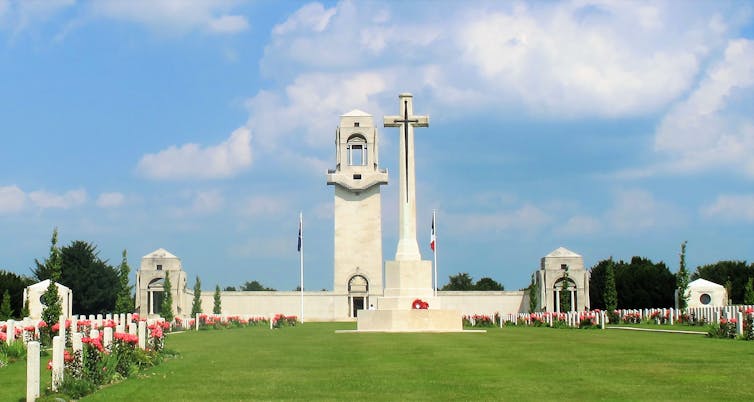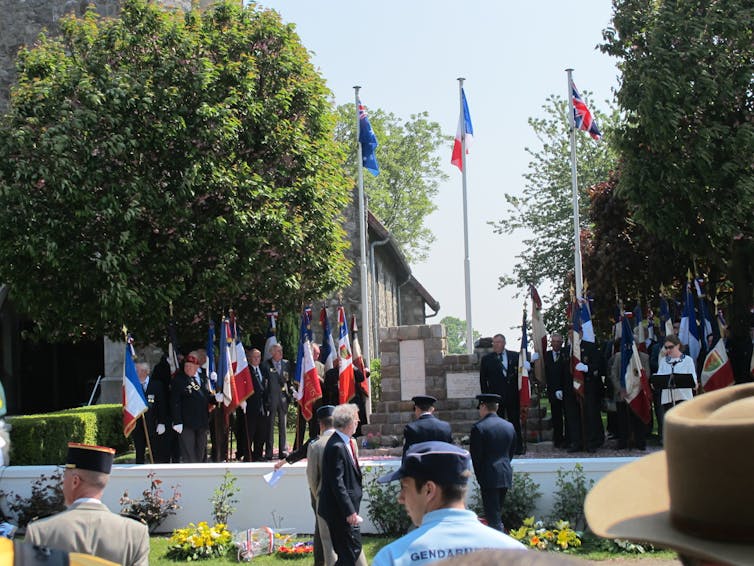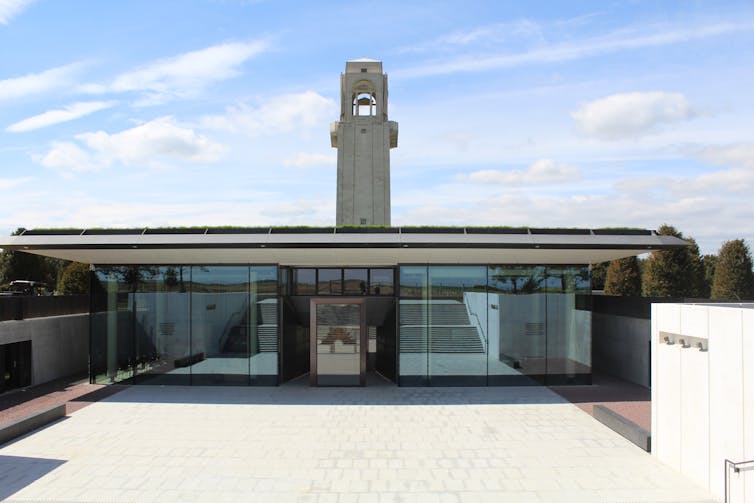do ‘the French’ care about Anzac?
- Written by Romain Fathi, Lecturer, History, Flinders University
When the first world war came to an end on the Western Front in November 1918, it was time for Australian soldiers to return home. As in Gallipoli, they left behind their fellow Australians who had died. But the Australian public felt less anxiety about the war graves on the Western Front than those in Gallipoli. France was a mostly Christian country, and an Allied nation. Surely, the French would deeply care about the Anzacs?
Soon after the war, the Australian government tried to impose the view that Australians had saved the city of Amiens. Canadians, British, French and others were claiming the same, as the Third Battle of Picardy had been an Allied operation.
 Australian commemorative plaque, Cathedral of Amiens.
author
Australian commemorative plaque, Cathedral of Amiens.
author
Realising that the good people of Amiens would certainly never believe that the Australians had done it all, Australian authorities turned their interest to much smaller villages to have their glorious – and often historically inaccurate – narrative displayed, and therefore ensure the commemoration of the Anzacs.
This worked well enough for them. Back in 1919, some French people were genuinely keen to contribute to the Australian state-sponsored glorification of the Anzacs in the Somme area. They were mostly motivated by the prospect of Australian pounds.
A few mayors clearly indicated that, for money, they would honour the Australian war dead, and chose to celebrate the Australian narrative of the war.
The French Mayor of Steenwerk, for instance, could not have been more explicit when he reached out to the Australian Governor-General in 1920, writing:
In return [for Australian financial assistance] we make this offer […] The old men of the Hospital will take care of [the remains of your gallant soldiers] and will consider it an honour to tend the graves and ornament them with flowers. On the front of the new edifice, we shall put the inscription: ‘In Memory of the Australian and New Zealand soldiers gloriously buried under our soil during the war of 1914–1918.’ Thus [your people] will have the satisfaction of thinking and knowing from the antipodes, [that] the memorial to their dead, associated to a charitable idea, will be perpetuated from generation to generation.
He wasn’t the only one. The Mayor of Villers-Bretonneux, Dr Jules Vendeville, was even more cunning in securing Australian financial assistance. He had a plaque made celebrating Australian heroes so that the Australian government would finally commit to building the Australian National Memorial at Villers-Bretonneux. The money started pouring in.
Instilling Anzac
Better yet, when the Victoria Villers-Bretonneux Fund based in Melbourne approached Dr Vendeville in 1922 to discuss how the money raised by Victorians could be used to help Villers-Bretonneux’s reconstruction and commemorate the sacrifice of Australian war dead, the mayor proposed public baths .. and an abattoir! You can imagine how this went down.
As a result, Australians, through Victoria’s then director of Education Frank Tate, raised the idea of a commemorative school, but the Mayor of Villers-Bretonneux did not want this.
Instead, the French mayor simply crafted a deceptive financial system, which would lead Australians to believe that all of their money went to rebuild what is today Victoria School at Villers-Bretonneux, while actually using parts of the funds for different purposes.
In the interwar period, the school kids of Villers-Bretonneux were entrusted with keeping the memory of the Anzacs alive. Tate was the one who had the “Do not Forget Australia” signs put in each classroom of this small primary school in rural France. It was, essentially, propaganda.
 The Australian National Memorial, Villers-Bretonneux, France. The memorial commemorates nearly 11,000 Australians with no known grave.
Author provided
The Australian National Memorial, Villers-Bretonneux, France. The memorial commemorates nearly 11,000 Australians with no known grave.
Author provided
And so it was that in the 1920s, on the Western Front, the memory of Australian soldiers was in fact promoted and paid for by Australian authorities, rather than the French. The French had other priorities – and who could blame them?
Australians and the British had it comparatively easy during the war. France lost nearly 1.4 million soldiers (and 7.2% of its population overall), and a fifth of its territory was utterly and completely destroyed. That level of devastation, to this day, is barely comprehensible for those who have not visited the Red Zone around Verdun.
Still, the remembrance of Australian soldiers was not always financially motivated. Some locals remembered the diggers fondly, as they also remembered soldiers of the 30 or so Allied nations who had come to fight in France.
In fact, had it not been for a handful of French people who founded in 1955 the Welcome Committee, which then became the French-Australian Association of Villers-Bretonneux, the French memory of Australian soldiers in the Somme would have all but disappeared in the 1960s and 1970s. As a thank you, some of the members of this association were bestowed with the Order of Australia, once the Anzac legend became a commodity in high demand for Australian politicians in the 1990s.
Putting tiny towns on the map
As time progressed, other villages in Northern France saw how Villers-Bretonneux was benefitting from tourism and the visits of Australian politicians. They too wished to reap the rewards of this memory boom. The towns of Bullecourt and Vignacourt both renamed one of their streets Rue des Australiens in the late 1980s. Soon after, Australian-funded memorials were built and visitors came.
But what’s in it for these French villages? While observing Anzac Day ceremonies at Bullecourt in 2011, an official from the Australian Embassy in Paris told me it “puts them on the map”. The French had known this for a while. The local newspaper La Voix du Nord reported in the early 1990s: “Paradoxically, Bullecourt (a small village south of Arras) is better known in Sidney [sic] or in any other town in Australia, than in France.”
In its article, the newspaper felt obliged to locate Bullecourt in relation to nearby Arras because even French readers would not necessarily know of its existence. For most French, these Australian “battlefields” were entirely unknown and of too small a scale to be remembered.
 Anzac Day ceremony, Bullecourt, 2011.
Author provided
Anzac Day ceremony, Bullecourt, 2011.
Author provided
Since the 2000s, with cheaper airfares and what historians have coined the “return of Anzac”, more and more Australians have visited the former Western Front in France and Belgium. This interest was fostered by former prime minister John Howard, who preferred the Western Front’s association with victory to the defeat at Gallipoli.
Tens of millions of Australian dollars were spent developing new commemorative sites for Australians to visit, at times helped along by some French euros to boost local tourism.
Australians funded and created more commemorative sites in France between 1998 and 2018 than between 1918 and 1938. Anzac is indeed a big industry.
 Anglo commemorative tourism has boomed on the former Western Front in the last 20 years.
Author provided.
Anglo commemorative tourism has boomed on the former Western Front in the last 20 years.
Author provided.
Before the Australian government took over the organisation of Anzac Day commemorations at Villers-Bretonneux and turned them into a big TV show, they were a small affair where French locals and visiting Australians would gather after the service for a luncheon. In 2001, however, the Australian Embassy stopped funding lunch, as too many locals were coming for the free food without attending the ceremony.
Australia a minor player
Beyond these small villages, most French people are unaware that Australians fought in the first world war. The second world war and its stories of resistance and collaboration have dominated France’s official memory landscape instead. Until the centenary of the WWI, fewer French people were interested in that conflict, compared to the huge network of associations and museums dedicated to WWII.
Furthermore, the French national curriculum in history does not discuss Australia’s engagement in the first world war. It mentions the involvement of the colonies but France had its own empire back then.
Additionally, the French didactic approach is more cultural than military, and the emphasis is put on Franco-German reconciliation. National school textbooks insist on the story of European integration. So the causes, the consequences, the mass violence, the horror and the uselessness of the war, as well as the idea of total war, are what is studied rather than which troops fought in what village.
And although proportionally the number of Australian volunteers was relatively high with regard to the total Australian population, they represented less than 0.6% of the total number of soldiers involved in the first world war.
Put simply, unless a French person has done more reading than usual about this war, extensively visited the former front, or happens to live in one of the few villages where Australian troops were involved, then they are very unlikely to be aware of the engagement of Australian soldiers in it.
Commemorative diplomacy
While the vast majority of French are unaware of the Anzacs, their government has recently rediscovered this shared page of history. Throughout the negotiations for the huge $50 billion sale of French submarines to Australia, French authorities lavishly praised the Anzacs.
The French State started sending senior representatives to Villers-Bretonneux for Anzac Day instead of local officials, the Champs-Elysées was bedecked with French and Australian flags for subsequent state visits, and Australia (with New Zealand) was chosen as guest of honour for the 2016 Bastille Day parade. No effort was spared to seal the deal.
In 2015, the French government welcomed the idea of the Sir John Monash Centre, which has since been built on the grounds of the Villers-Bretonneux Military Cemetery in northern France. No French historians were involved in the project, though. The centre tells the Australian version of the war, tinged with nationalism, and showcases a very self-centred and biased narrative of the conflict.
Again, the French don’t mind too much: not only was this $100m project funded by the Australian taxpayer, it will generate more tourism to a now essentially rural region, devastated by the economic crisis of the 1980s, which does not attract tourists as Paris, Provence or Brittany do.
 Front exterior of the John Monash Centre.
Author provided.
Front exterior of the John Monash Centre.
Author provided.
Since the Australian National Memorial at Villers-Bretonneux was unveiled in 1938 – and only then because King George VI was performing that ceremony – no French Prime Minister had set a foot at the memorial until 25 April 2018 when the Monash Centre was unveiled.
There, French Prime Minister Edouard Philippe paid tribute to Australian soldiers. But don’t be fooled, homage paid to the glorious Australian heroes is paid elsewhere to the Canadians, the Irish, the Indians, the Americans, the South Africans etc etc. Commemorative diplomacy cares little about history, but does much to facilitate the countries’ political and commercial agendas of the day.
What about the Moroccan division?
So why do we care about the French remembering the Anzacs? Why does the press, every year, feature articles about the French commemorating Australian service? Is this a remnant of a lingering colonial insecurity, whereby we can only exist as a nation if others acknowledge that we are one?
This craving to be bigger than Ben Hur when it comes to first world war extraterritorial commemorations is also a convenient vehicle with which to locate Australianness outside of Australia, and therefore shift the national narrative away from the story of dispossession.
Perhaps we shouldn’t care too much whether the French or anyone else remember the Anzacs. National self-worth can’t come from overseas. As Malcolm Fraser put it:
The constant need to be aggressive about one’s national identity, to vociferously reaffirm it, usually indicates a sense of inferiority towards other nations. Being able to regard oneself as an Australian, being able to contribute to Australia, does not depend on outward symbols.
 French, British, Canadian, Australian war graves alongside those of the soldiers of the Moroccan Division, testifying to the allied nature of the Second Villers-Bretonneux operation. Crucifix Corner Cemetery.
Author
French, British, Canadian, Australian war graves alongside those of the soldiers of the Moroccan Division, testifying to the allied nature of the Second Villers-Bretonneux operation. Crucifix Corner Cemetery.
Author
Instead of desperately wishing others to remember us, perhaps Australians should change their perspective. At the new Monash Centre, Australians don’t remember or discuss the French Army’s Moroccan Division, which relieved the AIF’s 52nd Battalion during Second Villers-Bretonneux in late April 1918.
This was a joint operation, so why make it Australian? We can’t expect others to remember us if we don’t remember them.
Authors: Romain Fathi, Lecturer, History, Flinders University
Read more http://theconversation.com/friday-essay-do-the-french-care-about-anzac-110880





